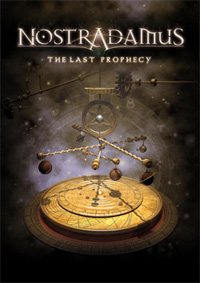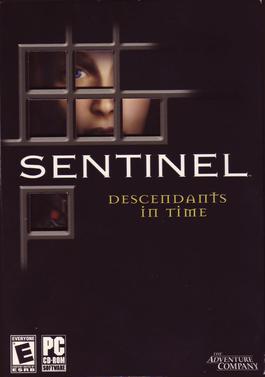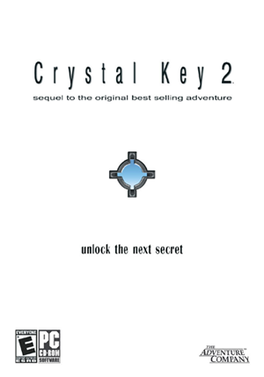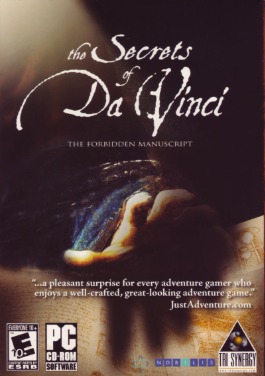
Voyage: Inspired by Jules Verne is a point-and-click adventure game with pre-rendered graphics, developed by Kheops Studio and published by The Adventure Company for the PC in 2005. The game's story focuses on a French adventurer's journey to the Moon in the 19th century, and the ancient lunar civilization he subsequently finds.

Pharaoh is an isometric city-building game released in November 1999. It was created by Impressions Games and published by Sierra Studios for Microsoft Windows. Using the same game engine and principles of Caesar III, it is the first such game in Sierra's City Building series to focus on another civilization of ancient times. Players oversee the construction and management of cities and settlements in Ancient Egypt, micro-managing every aspect of the city to ensure citizens are fed, employed, healthy and protected from diseases, disasters and wars. An expansion pack, Cleopatra: Queen of the Nile, was released in 2000, developed by BreakAway Games. In 2001, both the game and expansion pack were bundled together as Pharaoh Gold. A remake titled Pharaoh: A New Era was released by Triskell Interactive and Dotemu in 2023.

Return to Mysterious Island is a 2004 graphic adventure game developed by Kheops Studio and published by The Adventure Company. Based on Jules Verne's 1875 novel The Mysterious Island, the game casts the player as Mina, a shipwrecked woman forced to survive on an uncharted island.

The Omega Stone is a Microsoft Windows puzzle adventure game developed by American studio Omni World Studios. It was the sequel to the game Riddle of the Sphinx: An Egyptian Adventure and was released by DreamCatcher Interactive on March 18, 2003.

Sinking Island is a third-person perspective adventure game that uses point and click game mechanics. It was released in France on October 4, 2007, and in the United States on August 12, 2008. It was developed by White Birds Productions, a company founded and led by Benoît Sokal.

Kheops Studio was an independent video game development studio created in September 2003. Its games were published by Microids, which acquired the brand and intellectual property as insolvency assets of Cryo Interactive in 2002. The company was co-founded by Benoît Hozjan, who also served as the creative director for the studio and Stéphane Petit, who served as technical director. Kheops developed adventure games for the PC platform and released several major successful games. The studio is best known for creating games that have been described by the developer as "cultural entertainment", that is, games which are heavily drawn from historical or literary sources to include a mixture of history and fiction. After filing for bankruptcy, the studio was closed down in January 2012.

Echo: Secrets of the Lost Cavern is a computer adventure game released in 2005. It was developed by Kheops Studio and published by The Adventure Company. It is very similar to previous Kheops Studio games; the interface and gameplay are almost identical to Return to Mysterious Island. The player takes the role of Arok, a 15-year-old European Homo sapiens from the Paleolithic period.

Destination: Treasure Island is an adventure game developed by Kheops Studio and published by Nobilis. The game comes from the creators of The Secrets of Da Vinci, Return to Mysterious Island, Voyage and many more.

Safecracker: The Ultimate Puzzle Adventure is a 2006 puzzle adventure game developed by Kheops Studio and published by The Adventure Company. It is the spiritual successor to Daydream Software's 1997 title Safecracker.

Disney's Dinosaur is a 2000 video game published by Ubi Soft, and functions as a tie-in to the Disney film of the same name.

Dracula 3: The Path of the Dragon is a 2008 point-and-click adventure video game developed by Kheops Studio for Microsoft Windows, and published by MC2 France under their Microïds label in Europe and Encore in North America. In 2010, an abridged version of the game developed by Tetraedge Games and published by Chillingo was released in a three-part episodic form for iOS. The full version of the game was ported to OS X in 2010, published by Coladia. Also in 2010, the three-part iOS version was made available for PC as the Dracula Series. In 2014, the abridged iOS version was made available as a single game on Steam.

Egypt III: The Fate of Ramses, known as The Egyptian Prophecy in North America, is a 2004 graphic adventure game developed by Kheops Studio and published by The Adventure Company. The player must solve an array of ancient riddles that will help a dying Pharaoh survive and restore Egypt to glory. The game is the third and final game in the Egypt trilogy, following Egypt 1156 B.C. and Egypt II: The Heliopolis Prophecy. In 2010–2012, Microïds released an adaptation of the game called Egypt: The Prophecy, split into parts, for the Apple iPhone.

Nostradamus: The Last Prophecy is an adventure video game developed by Kheops, Mzone and Totm. It was a co-production by Elektrogames, Kheops Studio, MC2, Mzone, Totm, and Anuman Interactive, and is published in the US by MC2.

Nikopol: Secrets of the Immortals is a point and click adventure game developed by White Birds Productions and based on the graphic novels of Enki Bilal's The Nikopol Trilogy.

Gray Matter is a point-and-click adventure game designed by Jane Jensen, creator of the Sierra Entertainment Gabriel Knight series. The game was developed by Wizarbox and published by DTP Entertainment for Microsoft Windows and Xbox 360. It was released in November 2010 in Continental Europe and in English-speaking territories in 2011.

Murder In The Abbey is an adventure video game, developed by the Spanish studio Alcachofa Soft and released in 2008. The game is inspired by the 1987 title La Abadía del Crimen.

Sentinel: Descendants in Time is a "puzzle-adventure, Myst-clone" video game released in 2004.

Crystal Key 2, known in Europe as Evany: Key to a Distant Land, is a 2004 graphic adventure game developed by Canadian studio Earthlight Productions, together with Kheops Studio. It was published by The Adventure Company, and is the sequel to the 1999 title The Crystal Key.

The Secrets of Da Vinci: The Forbidden Manuscript is an adventure game developed by Kheops Studio and published by Tri Synergy for Windows. In 2009 it was released on the Mac OS X.



















